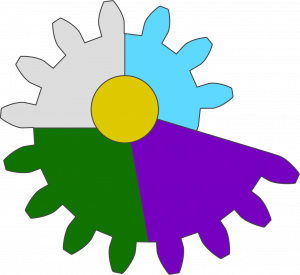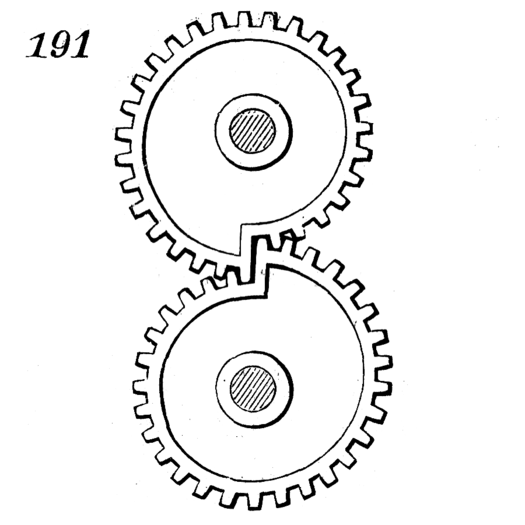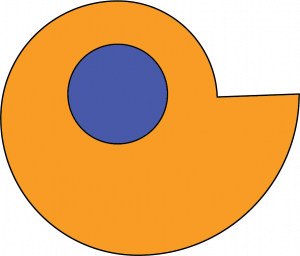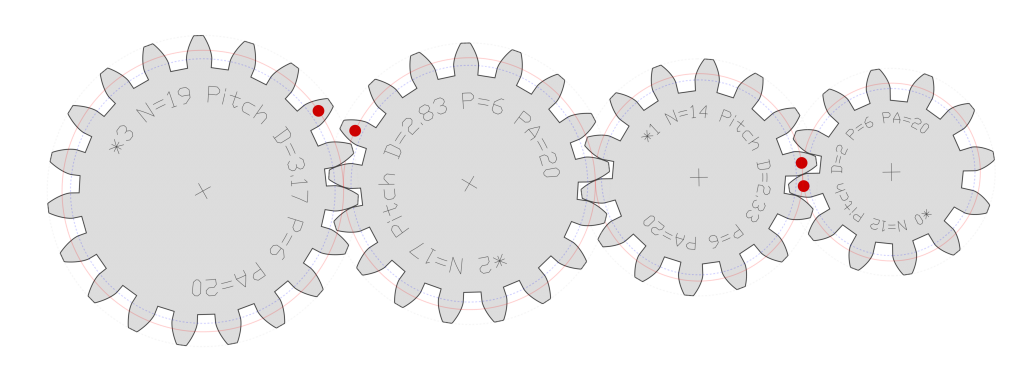This is Mechanical Movement number 191, scroll gears:
Their variable radius allows them to change speed and torque throughout each revolution. As the drive gear’s radius increases, the speed of the driven gear increases and vice versa. This can create an interesting “stepping” movement:
I started off on my journey of drawing by just importing the drawing into Illustrator. It quickly became clear that this wouldn’t be as quick as I thought. The original drawing isn’t great quality; teeth are poorly defined and lines aren’t exact. Tracing it wouldn’t yield the best results. Instead, I redrew the gear with the image as more of a guide.
The first challenge came in making the general shape of the gear. Instead of a normal circle, scroll gears follow a spiral path. I didn’t (and still don’t) know how to make a precise, mathematical spiral in Illustrator, so I made an approximation with overlapping circles. Each quarter was larger than the last by some ratio. I chose the golden ratio, for not much reason other than it was the first thing that popped into my mind when thinking about spirals and ratios. As with any exponential function, this got much too large, much too fast. I reduced it to the cube root of the golden ratio (1.618^(⅓) = 1.174) so after a full rotation, three enlargements, the radius would have increased by the golden ratio. I placed the circle quadrants next to each other so that the curve lined up, creating this figure:
Great! Now we have a spiral gear base to build upon. Now all that’s left is to add teeth and we’re done!
Whoa, not so fast. What shape should your teeth be? How do you get teeth to line up evenly? Now how do you do that on a spiral?
Question one: involute teeth. Most gears use these kinds of teeth because they’re the most effective at transferring force along the line of action (thanks ENGI 120). Question two: take the outline of a tooth, make a mirror of it, then copy-paste radially around the gear. Question three: no idea. I was stumped for a bit, wondering if it was possible for me to accurately draw teeth on a spiral. Then I decided it wasn’t necessary. Much like the circles used before, I could use pre-made gears whose size corresponds to some ratio and overlay them to create a toothed spiral shape. A quick search found https://geargenerator.com, which let me quickly make these:
Then, using the same procedure for the circles, I quartered the gears and made this frankenstein:
With a bit of pathfinder glue, a quick copy-paste, and rotation:
Ta-da! Scroll gears, with much higher speed variation than the original. You can see that the shape isn’t exactly a golden spiral. In fact, the ratio between the maximum and minimum radii is closer to 11/6. This is due to the approximation technique centering in on a circle who shares a center with the first quadrant and the small adjustments necessary to make the gear teeth work. Ultimately, the exact ratio doesn’t really matter for this, and trying to be overly exact isn’t the best time investment. Golden ratio or not, the gears will still work.
I think I can settle for silver.




